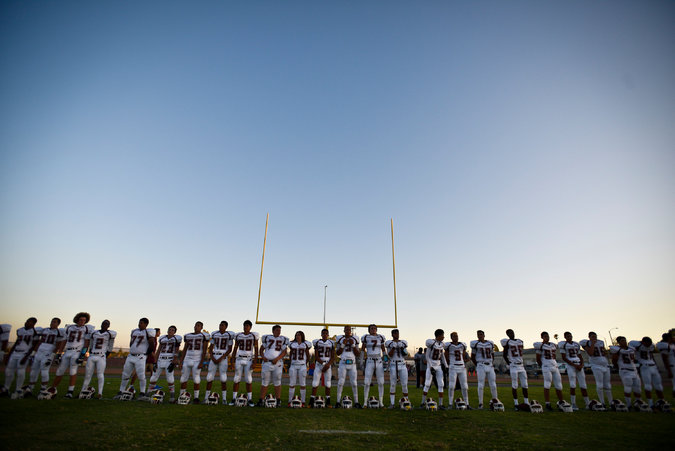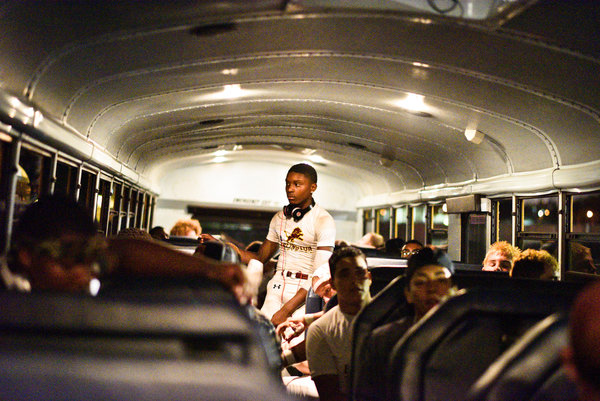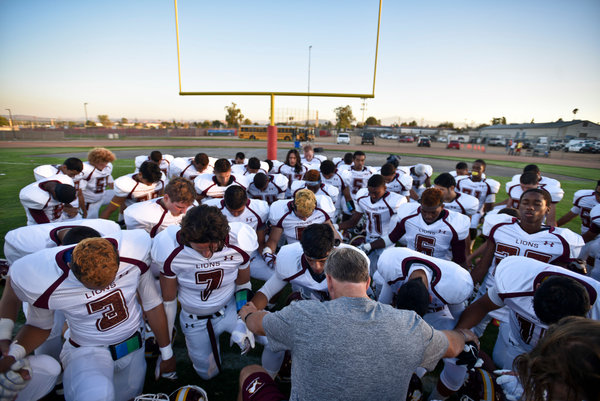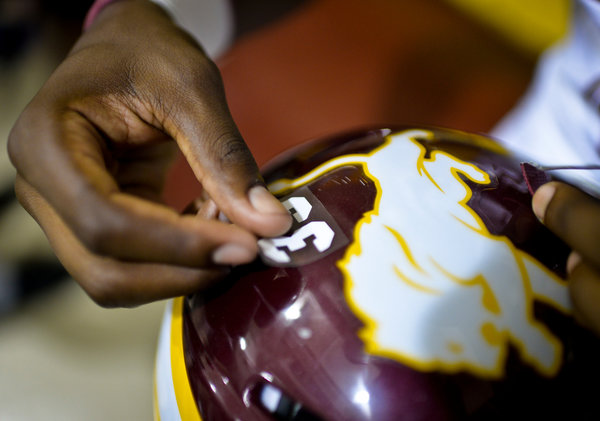
The annual homecoming game was scheduled to end the football season at Minnesota’s Cherry High School earlier this month. By then, however, the game had been forfeited and the season canceled because of injuries. Instead, the Cherry High boys healthy enough to play lined up against a team of alumni in a game of flag football.
“I told everybody that we’re not quitting on anybody,” Coach Justin Bakkethun said. “We’re just looking out for their safety.”
His is a growing sentiment. Similar examples are scattered across the American landscape this fall, as high school football games and seasons have been canceled over concerns over the dwindling number of healthy players. Rosters, already thinned by declining interest in football at some schools, have been further reduced by injuries to the point that coaches and administrators have opted to pull the team off the field entirely.
“I never thought in a million years that I’d have trouble finding kids to play,” Bakkethun said.
Similar circumstances have ended games or seasons in places like West Seattle, Wash.; Bay City, Mich.; and Plattsburgh, N.Y., in the past few years. But the steady reports of forfeitures makes this season stand out.

At Cheyenne Mountain High School in Colorado Springs last week, the initial football roster was pared from 45 boys to 12 through a mix of dismissals, eligibility issues and injuries. Athletic Director Kris Roberts told The Gazette of Colorado Springs that three boys were out from concussions and five others from serious injuries.
Cheyenne Mountain has an enrollment of roughly 1,300 and made the state playoffs in football three years ago. But it canceled the remainder of the season because it did not have enough healthy boys.
The same thing happened in Portland, Ore., where Madison High School last week forfeited its final game of the season because of injuries.
“After looking over the injury reports from the varsity team, with the student safety in mind, we feel it is best to discontinue play at the varsity level,” Principal Petra Callin wrote on the school’s website.
It has been at least 30 years, officials said, that football games have been canceled at Portland Public Schools because of injuries or a lack of players. Christine Miles, a district spokeswoman, said that 10 or 12 of the 29 players on the team had sustained concussions.
Tightened protocols in the past couple of seasons, as awareness of concussions has grown considerably, makes returning to the lineup more difficult.
Roughly half the roster at Madison, a school of 800 students, consisted of undersized and inexperienced freshmen.
“When it came down to that they were playing both sides of the ball, against seasoned varsity teams, it became a safety issue,” Miles said. “Are we doing the morally correct thing?”

Frederick Rivara, professor of pediatrics at the University of Washington and Seattle Children’s Hospital, and vice chairman of an Institute of Medicine committee that studied concussions in children, noted that all states now have concussion protocols for youth sports. The increased public awareness of concussion risk is likely taking a toll on participation numbers in football.
“I think that’s true,” he said. “More people are aware of the risks. And coaches are doing a better job of understanding what concussions are, recognizing them when they occur, and teaching the sport in ways to lower the risk of getting injured.”
A shift in how a community views football is particularly vivid at Arlington High School in Riverside, Calif. Tyler Lewellen, a 16-year-old defensive back, died after sustaining a brain injury in a scrimmage at the start of last season, and the tremors of that incident are still shaking the football program.
The Lions haltingly played on last season, through their grief and fears. Ultimately, they gained a measure of satisfaction by persevering, honoring Lewellen’s memory and reaching the playoffs for the eighth consecutive season.
This season was supposed to be a return toward normalcy. But participation plummeted so sharply that the junior varsity team was dropped, while the aversion to contact in a sport that demands it has remained, as has a heightened awareness of injuries. The Lions are 0-8, and none of their games have been close.
Four players have been held out of games after suffering concussions, and Friday snapped a streak of three consecutive weeks that a player ended up in the emergency room for an injury. Earlier in the season, another player was transported from practice to a hospital by ambulance when he complained of a tingling pain in his neck and shoulder area after a collision. The injury was diagnosed as a stinger.
“The cloud has affected us way more than any of us thought it would,” said Eric Seckinger, in his 21st season as an assistant coach. “You need to block and tackle to play football, and I think we’re afraid to hurt somebody. Even though what happened with Tyler was an anomaly, I think we’re all a little gun-shy.”
Measured by participation, football remains the most popular high school sport in the United States, by a large margin. Last fall, more than 1.1 million boys played high school football, according to the National Federation of State High School Associations.

But the number has dropped slightly in recent years, while participation in other high school sports has grown. From 2008 to 2013, the number of boys playing football fell about 17,000, while the number of boys participating in other school-sanctioned sports rose by about 122,000, according to the national federation.
Participation has long been a concern at small schools, where the vagaries of class size and other interests can leave a varsity team depleted, even without injuries. Tiny Lincoln High School in Lincoln, Mont., plays the six-man version of the game, rather than the usual 11-man, but forfeited the season because it had only five players. A year ago, it had 18.
In the center of Illinois, in the heart of the country, three rural schools combine to field an 11-man football team called River Valley. In a game early in the season, the 17 players were reduced to 12 by injuries. With a few minutes left in the third quarter, after meeting with administrators and officials, the game was called.
River Valley did not cancel its season, but has forfeited five other games because it could not field a team. Rolf Sivertsen, the Midland Schools superintendent, believes that parents are keeping their boys away from football because of growing concerns over concussions. And with small rosters, anyway, a few injuries can end a season.
“I worry about the future of football in all rural schools, not only in Illinois but across the country,” Sivertsen said. “Every time you turn on the television, all you hear is bad things about youth football.”
In Cherry, Minn., the high school participates in nine-man football. Bakkethun began the season with 18 players. One moved away. The starting quarterback was lost to a broken collarbone. The top running back was one of several boys sitting out with concussions. Others sustained a ruptured ear drum, another hurt a foot and a third broke his hand.
When the team arrived to a recent game with 11 players, the school decided to forfeit. Now Bakkethun worries about the long-range future of football, at his school and beyond.
A meeting is scheduled for the community to discuss the future of the football program. Bakkethun is optimistic that there will be football in Cherry next fall, and for many falls after that.
But he admitted that high school football might be in for a long fight with the growing threat of concussions.
“With so many concussion cases, people are more concerned,” he said. “I’ve talked to other coaches who have lost some kids from the concussions scares. You ask the kids, ‘What’s the reason?’ and they say, ‘Oh, I’ve lost interest’ or something. But I think it’s in the back of kids’ minds that so-and-so got hurt. Will I get hurt, too?”